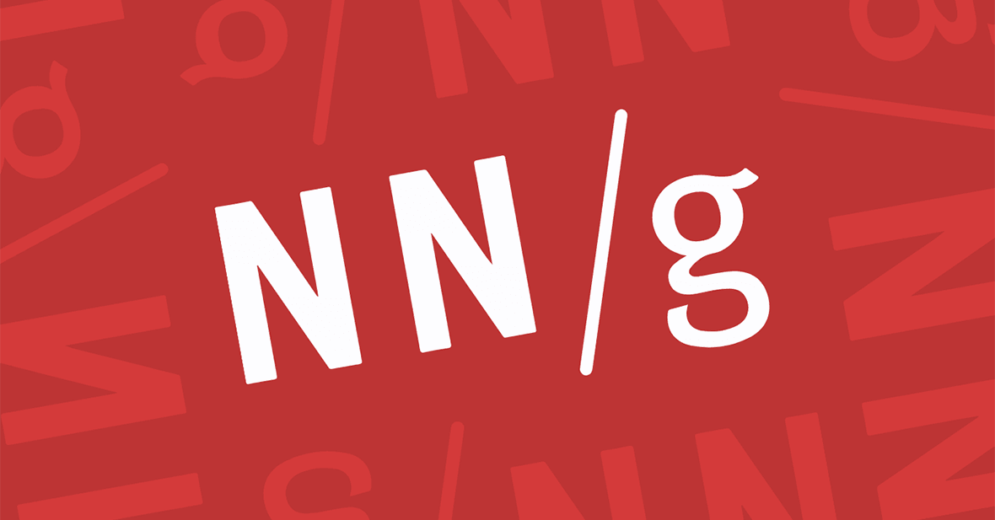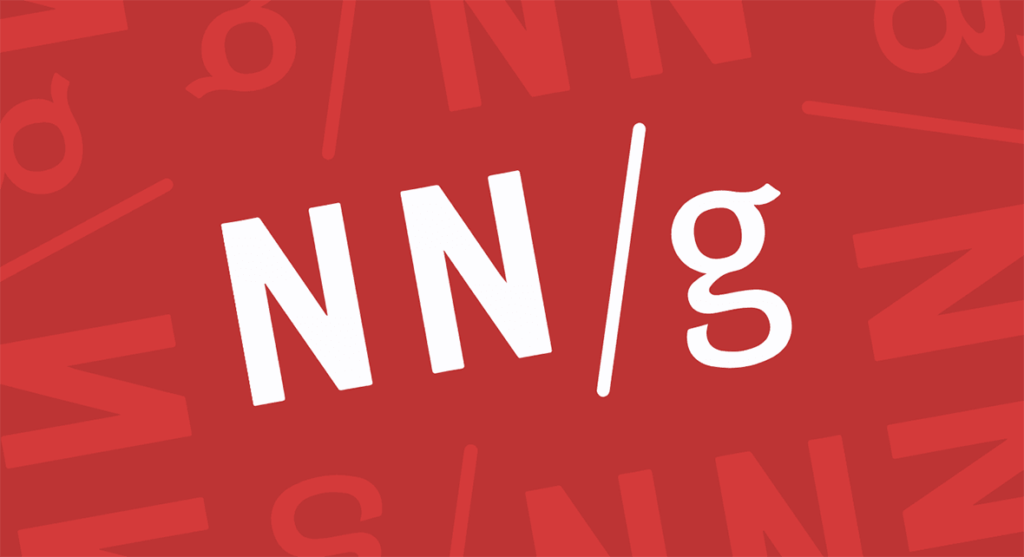Embarking on a new career path always gives an excited tingle in the stomach! One way to embrace this anticipation is by creating a well-thought-out plan and researching the career you aspire to pursue.
When it comes to UX Design careers, the esteemed Nielsen Norman Group is a true authority in the field.
And guess what? They've got a treasure trove of information and research about UX Design careers that can help shed light on the profession and give you a glimpse of what to expect.
Are you ready to unlock the secrets of a career in UX? Let's dive right in and discover what lies ahead!
In the meantime, professionals handling both UX Design and UX Research tasks can view it as an opportunity for growth and skill development. By gaining expertise in both areas, they become versatile and well-rounded practitioners in the UX field.
NN/g report about UX careers
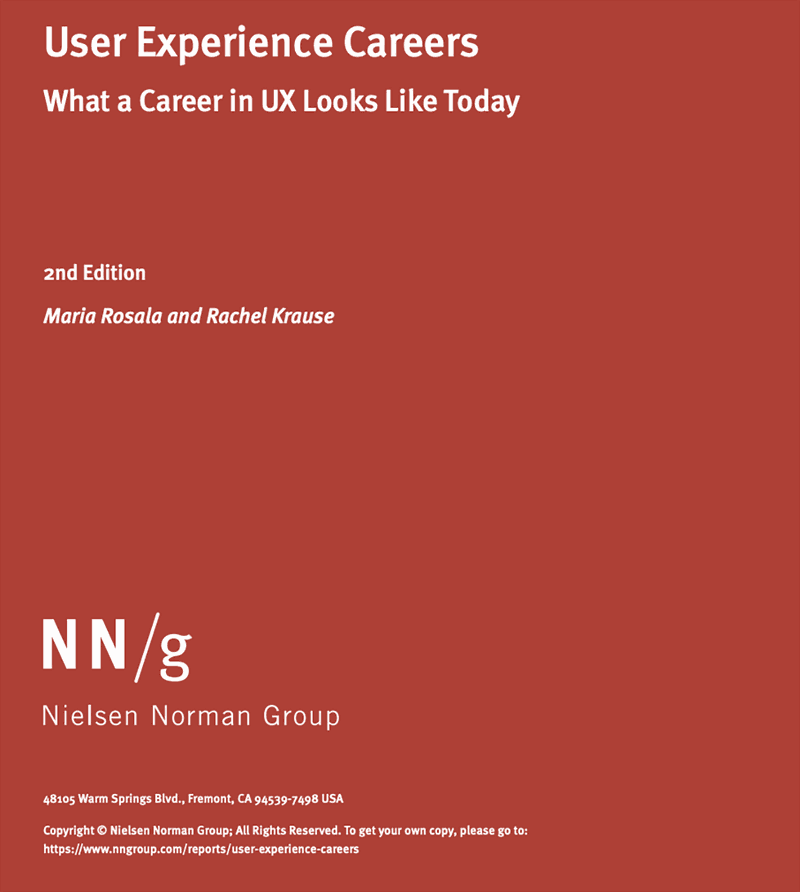
The foundation for this article is the report compiled by the Nielsen Norman Group: User Experience Careers – What a Career In UX Looks Like Today.
This report serves as an update to a previous edition, which we've also written detailed articles about, covering all its findings and insights.
The update is based on research conducted in 2019, providing valuable and up-to-date information on careers in UX.
If you're eager to delve deeper into the topic and explore the previous NN/g report, we invite you to check out these two other articles:
- How to Build a Career in UX Design – Part 1
- How to Build a Career in UX Design – Part 2
Now that we've set the stage let's dive into the key findings from the report.
Different job titles, same roles
When it comes to UX careers, there's a fascinating discovery from the report: there's an abundance of job titles in the field of UX Design. In fact, the survey revealed a whopping 134 different job titles related to UX!
You might be wondering, why such a variety? Well, there are a couple of reasons our talented professionals gave:
- Many respondents wear multiple hats in their UX roles, which explains the combination of titles. Think of someone being both a UX Researcher and a Designer—talk about versatility!
- Some participants actually hold positions outside the traditional realm of UX Design but still engage in UX activities. It's likely because their companies don't have a dedicated UX department yet, but they recognize the importance of UX and incorporate it into their work.
The multitude of job titles highlights the dynamic nature of UX Design and the diverse responsibilities it entails. So, if you've come across a myriad of UX job titles, now you know why!
Grouping job titles together
But don't worry; the NN/g has managed to sort through the sea of job titles and grouped them into 6 main categories. Let's take a closer look, along with the percentage of respondents in each group:
- Designers (48%): These creative folks are the ones who bring the UX vision to life, focusing on crafting user-friendly experiences.
- UX Managers, Leads, or Directors (15%): These are the superheroes of the UX world, leading teams and shaping the overall UX strategy.
- Non-Specialist UX roles with multiple titles (12%): These versatile professionals wear many hats, juggling various UX responsibilities and job titles.
- Researchers (12%): Meet the detective squad of UX! These individuals dig deep into user behavior and insights to uncover valuable findings.
- Content Specialists (1%): These wordsmiths have a knack for crafting compelling and engaging content that enhances the user experience.
- Others (11%): This catch-all category includes job titles that didn't fit neatly into the other groups but are still valuable contributors to the UX field.
Having many job titles, often referring to similar roles, can be overwhelming and confusing for those entering the UX realm. It's important for both job seekers and employers to navigate this landscape with clarity and understanding.
By simplifying and standardizing job titles in the UX industry, we can create a more cohesive and accessible career path, making it easier for aspiring UX professionals to find their way and for organizations to hire the right talent.
So, let's work together to make the world of UX a little less confusing and a lot more awesome!
Reading tip: UX Design: What Are the Possibilities for Working in the Field?
Are the responsibilities the same?
We've noticed that there are various job titles for similar roles, which we were able to group into larger categories.
But despite this, do these roles have well-defined responsibilities? Or do UX Designers also perform the tasks of UX Researchers and vice versa?
According to the report, there are common responsibilities across these roles. However, it's worth noting that the role of UX Researcher tends to have "fewer responsibilities" compared to other positions.
While UX Designers often also perform UX Research tasks, the reverse is not always true. But does this mean that the role of UX Research is undervalued?
Not necessarily. The issue lies in the fact that companies are still adapting to the reality of UX Design, despite it being a rapidly growing market.
As a result, more mature UX organizations have well-defined roles and responsibilities, whereas less mature companies may not. In the latter case, UX teams are typically lean, and both UX Design and UX Research responsibilities often fall upon a single professional.
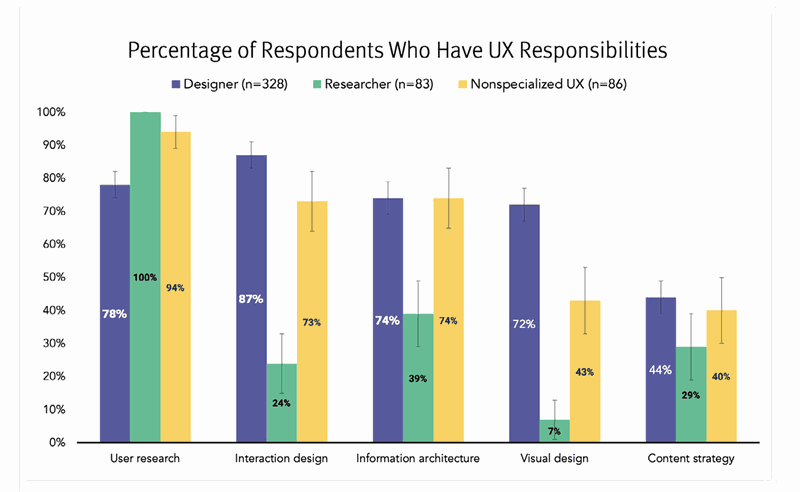
UX Design Maturity
It's important to note that the perceived value of UX Research is not necessarily diminished by these circumstances. Rather, it reflects the ongoing evolution of UX within different companies.
As the field continues to develop, organizations will increasingly recognize the importance of dedicated UX Research roles and the unique insights they bring.
In the meantime, professionals who find themselves handling both UX Design and UX Research tasks can view it as an opportunity for growth and skill development. By gaining expertise in both areas, they become versatile and well-rounded practitioners in the UX field.
As the industry matures, it is expected that companies will establish more specialized roles and acknowledge the distinct value that UX Research brings.
This evolution will lead to better team structures and enhanced collaboration, ultimately benefiting the overall user experience.
Therefore, while the distribution of responsibilities may vary across companies, it's important to appreciate the value of UX Research and the ongoing adaptation within the UX Design landscape.
Reading tip: How to Identify the UX Design Maturity of Companies?
Where can a career in UX take you?
When considering a career in UX, you might initially think of working solely for software companies, apps, or websites. But here's the exciting truth: the world of UX is expanding, and many opportunities are waiting to be explored.
As more businesses recognize the impact of UX on their success, the range of possibilities keeps growing. According to the survey, UX professionals are thriving in various industries beyond the tech realm.
While software companies still lead the pack, it's interesting to note that only 28% of respondents work in this sector. Other intriguing fields emerge right after, including finance institutions like banks and insurers, consultancies that offer expert advice, and even educational organizations shaping the future of learning.
So, if you're passionate about UX, remember that your career path can extend far beyond the digital landscape. Embrace the exciting journey ahead and discover where your skills and creativity can make a meaningful impact!

If we compare it to the research conducted in 2013 – in the first edition of the report – we can see that the top industries have remained unchanged.
This means that the hiring of UX professionals is likely to be stronger in these markets.
What are the activities of a UX Designer?
The survey aimed to ask respondents about the activities they perform on a daily basis. The goal was to understand the most common activities practiced in UX Design and whether there are differences between roles.
Respondents were provided with a list of 20 activities and indicated which ones they frequently engage in.
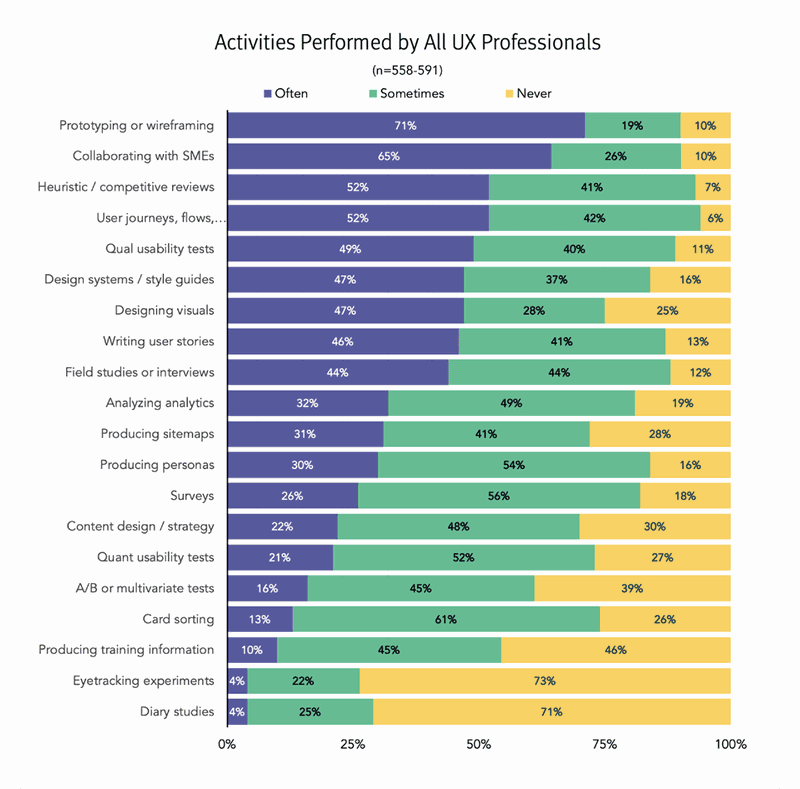
As a result, we observed that it is common for most professionals in UX careers to engage in activities such as:
- Prototyping and wireframing
- Collaboration with experts from other fields
- Heuristic evaluations
- Creating user journeys
- Conducting user testing
- Visual design
It is also important to note that the less common activities are visual studies and daily studies, which are two types of research methods.
Unfortunately, despite their importance, these methods are not widely practiced, and the majority of professionals report never having conducted this type of research.
By being aware of these activities and their potential impact, UX professionals can further enhance their skills and deliver exceptional user experiences.
Reading tip: User Interview: Keys to Gather Insightful Information
The different activities that Designers and Researchers perform
As a deeper analysis of the activities, the report separated the tasks UX Designers and UX Researchers performed. This allows us to gain insights into the distinctions between these two roles.

There are common activities between Designers and Researchers, such as:
- Collaborating with experts from other fields;
- Defining personas;
- Reviewing heuristics.
However, despite these similarities, we observe a clear distinction between these two roles in UX Design.
While Designers are more involved in activities like prototyping, visual design, and content creation, Researchers are responsible for tasks like user research and testing.
Therefore, these are complementary areas of expertise. A team that can count on different professionals with each expertise will be better equipped and prepared to work on their projects.
Education for a career in UX Design
The question of education is often a top concern for those aspiring to enter or transition into the field of UX Design. So, what kind of educational background is needed to become a UX professional?
Formal education
According to the research, a significant 82% of respondents have pursued some form of an undergraduate degree, while 31% are currently enrolled in or have completed postgraduate studies or an MBA.

Delving in further, the research revealed some trends between the respondents' undergraduate degrees and the roles they held.
As a trend, UX Designers often have degrees in design-related fields such as Graphic Design, Industrial Design, and Visual Design.
On the other hand, UX Researchers typically have backgrounds in fields like Psychology, Sociology, and Anthropology.
Lastly, content specialists often hold degrees in fields like Literature, Journalism, and Communication. Thus, we can see a correlation between UX roles and undergraduate degrees.
However, it's important to note that these trends are not restrictive, as a background in design is not necessary to transition into a career in UX Design.
Reading tip: How to leverage my background and transition into UX Design
Is a UX-related degree a guarantee of success?
There's no denying that a degree in a related field can be helpful for a career in UX, but it's only the beginning.
While professionals with backgrounds in Graphic Design or Sociology backgrounds, for example, may have technical skills in drawing and research that professionals from other fields may not possess. However, a UX-related degree is not a limiting factor.
Despite respondents acknowledging the usefulness of a related background, there is a consensus that it is not necessary to have a specific background in the field to excel in UX Design.
"Don't worry too much about your background. I've met UX professionals who come from different fields, from finance to anthropology. You don't need a specific degree to enter the UX Design career." – Respondent's comment
In addition to formal education, where can one study UX Design?
According to the survey, 35% of the respondents mentioned pursuing a UX Design-related degree.
However, the remaining 65% did not have a formal UX-related degree. So, how did they acquire the basic knowledge in the field?

Thus, we can observe that the majority of respondents who did not have a UX-related degree obtained knowledge through online courses. This mode of education is becoming increasingly popular, with a growing number of online courses available.
A portion of the respondents, specifically 21%, mentioned that they learned UX Design by reading books, articles, and other types of content, without necessarily enrolling in a formal course.
Reading tip: How I Got My First Job in UX Design in Switzerland – Interview With Kevin Panchaud
Transitioning to a Career in UX Design
Many survey respondents mentioned that they had never considered working or pursuing a career in UX Design.
However, they came across this profession through recommendations from colleagues or realized that they were naturally engaged in such activities, leading to an automatic transition.
Due to these unexpected paths, where professionals in UX did not plan for this career, it is a fact that anyone can start a career in UX if they so desire.
A career in UX does not require a specific background
This is a topic that we often discuss. Moreover, diverse backgrounds bring different skills that are important and relevant for a career in UX.
The research also emphasized this point. Many of the respondents reaffirmed this principle:
"My social psychology course deals with how people influence each other, and it has been very useful in UX Design to understand how people respond to certain stimuli."
"I prefer to bring someone who doesn't have a degree in design but is brilliant, committed, and has a positive attitude than to bring someone who only studied at a good school."
We've got plenty of interviews with our students, where you can check out real-life examples of people who have made a successful shift into a UX design career, even without any previous design or UX experience.
It's inspiring to see their journeys and how they've embraced this new path with determination and enthusiasm.
Changing careers: challenging but worth it
The majority of respondents expressed high levels of satisfaction and happiness with their careers in UX Design.
However, the path to a career change can be difficult, especially on an emotional and psychological level.
Some respondents mentioned experiencing moments of stress, insecurity, and anxiety. Luckily, these feelings were quickly outweighed by the satisfaction of their new career.
If you're interested in learning more about how to transition into UX, save this for later:
Essential skills in UX Design
The report also highlights the most common skills among the surveyed UX professionals.
The respondents indicated which skills they would like to have and which ones they considered unnecessary.
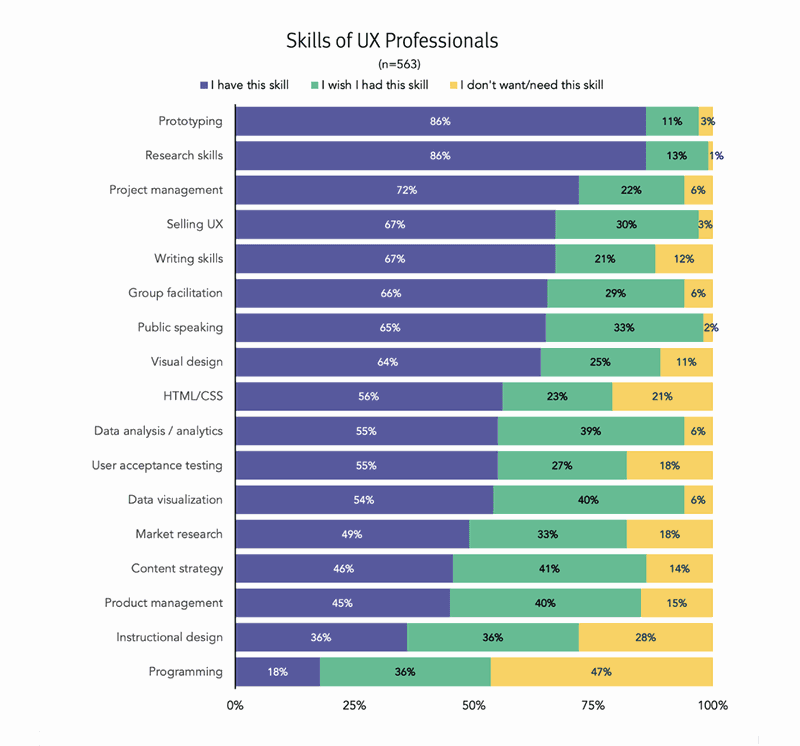
The most common skills in the UX career, therefore, are:
- Prototyping
- Research skills
- Project management
Skills of Designers vs Skills of Researchers
Once again, throughout the report, there is a comparison between the roles of UX Designers and UX Researchers.
This time, the objective was to compare the skills that each group possesses or lacks. UX Designers demonstrated that, in addition to prototyping skills, they also have considerable research skills.
This makes sense because many of them mentioned having research activities in their work. On the other hand, UX Researchers have fewer skills in prototyping and visual design. Programming skills were low for both roles.


Important skills in a UX Design career
Respondents were asked about the skills they consider important to have in a UX Design career.
Despite the relevance of technical skills, most participants highlighted behavioral skills – Soft Skills.
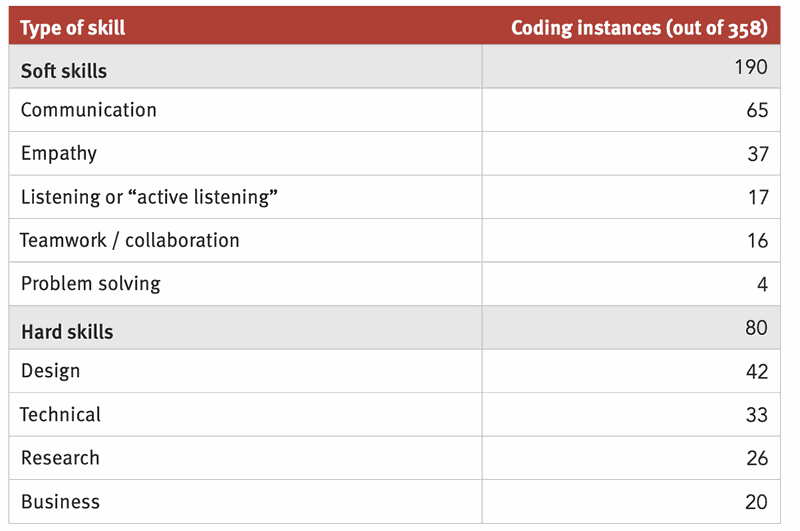
Over 50% of the responses were dedicated to behavioral skills, with the most common ones being:
- Communication
- Empathy
- Active listening
When we talk about UX Design and the concepts of User-Centered Design, it makes a lot of sense that Soft Skills are just as important, if not more important, than Hard Skills. After all, the work is based on the behavior and needs of people. It's all about people.
How to work on your Soft Skills?
The respondents mentioned that some important Soft Skills for a career in UX Design were developed through different backgrounds and experiences they had.
Such comments only reinforce the fact that a related background is not necessary to transition into UX Design. Moreover, a diverse background can be highly beneficial in the profession and career in UX.
Reading tip: 11 Fears That Hinder Your Transition to a Career in UX Design
Are UX Designers satisfied with their profession?
Throughout the report, we already mentioned a couple of factors indicating that respondents were quite satisfied with their careers in UX Design.
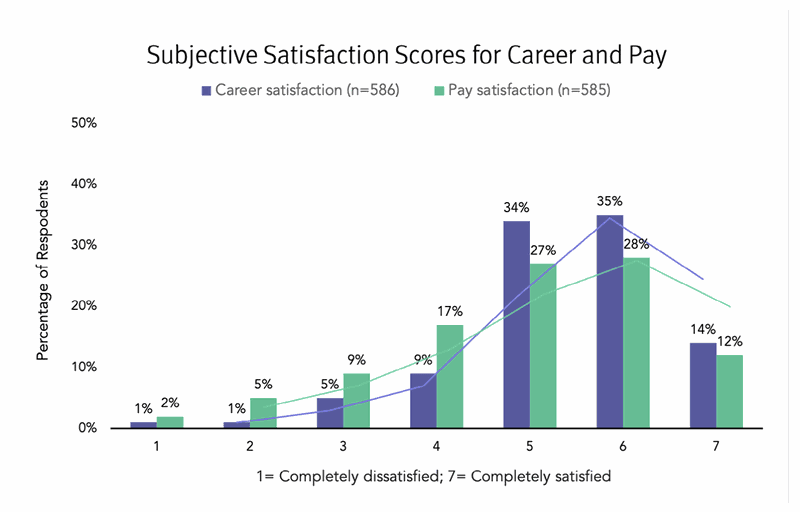
The reasons for satisfaction with a career in UX were:
- Enjoying the work and the processes involved.
- Seeing the impact of their work.
- Receiving recognition for their work.
- Good growth opportunities.
On the other hand, the reasons why professionals were not satisfied with their careers in UX were:
- Companies that lack growth opportunities.
- Limited opportunities due to lack of experience.
- Not being able to do proper UX work because companies still do not fully understand the role of this profession.
- Lack of access to training and mentoring.
- Burnout syndrome.
- Working in companies with an immature approach to UX Design.
What recruiters look for when hiring UX professionals?
A portion of the survey respondents were managers responsible for, among other things, hiring new professionals for their teams. Therefore, the survey asked them about what they look for in a candidate.
The majority of the responses mentioned the need for Soft Skills. The Soft Skills listed were:
- Curiosity and a thirst for learning.
- Emotional intelligence.
- Good communication skills.
- Confidence, passion, and empathy.
- Active listening.
- Humility.
- Creativity.
- Teamwork.
Therefore, the development of behavioral skills is highly important. In fact, these skills are closely observed even in interviews with entry-level and junior professionals.
Recruiters mentioned that they look for individuals who are interested and have the potential for growth, rather than those with extensive technical skills.
"When I hire beginners, I am more interested in how curious the person is, how interested they are in learning, and if they are open to new experiences. I look for that spark in their eyes." – Comment from a responding recruiter.
Of course, in addition to seeking the necessary Soft Skills, recruiters also assess candidates' technical abilities through design tests.
UX Design Portfolios
The majority of responding recruiters stated that a strong UX portfolio is a key element in their hiring processes.
Although the specific elements each recruiter looks for in portfolios may vary, most of them seek a demonstration of the candidate's thinking process.
Therefore, a good UX design portfolio should not focus solely on beautiful UIs and elements. Most of all, it should tell your story and showcase your thinking.
Your portfolio should demonstrate your problem-solving approach and provide insights into your design process.
So, your portfolio can include exercises and "fake" projects to illustrate your thinking process. For more tips on how to build your portfolio, you can check out these articles:

